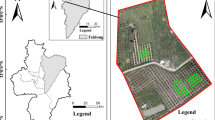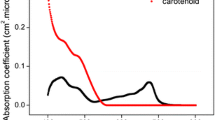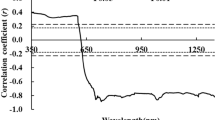Abstract
This paper assesses the capability of hyperspectral remote sensing to estimate chlorophyll a (Chl a), chlorophyll b (Chl b), and chlorophyll a + b (Chl a + b) concentration at cherry leaf scale using a variety of spectral variables during the growth season. A field experiment was conducted in cherry orchard. The leaf reflectance spectra of cherry plants were acquired within 350–1050 nm wavelengths. A variety of spectral variables were mathematically computed based on the leaf spectra and transformation of reflectance spectra. The relationships between all of spectral variables and chlorophyll concentration were discussed. Estimating Chl a, Chl b, and Chl a + b concentration by stepwise linear regression method and curve estimation method were carried out. Results demonstrated that the best spectral variable for prediction of chlorophyll concentration was the new spectral variable (the first derivative of log (1/R741) and D751/D511), with the root mean square error prediction (RMSEP) of 4.802 mg L−1 for Chl a concentration, 1.659 mg L−1 for Chl b concentration, and 6.419 mg L−1 for Chl a + b concentration. It should be noted that spectral variables such as D715/D705, EBFR, D705/D722, and BND showed a good performance with the RMSEP of 5.768, 7.838, 12.146, and 14.437 mg L−1 for Chl a concentration, 1.795, 1.985, 1.765, and 3.164 mg L−1 for Chl b concentration, and 7.935, 11.49, 17.99, and 21.79 mg L−1 for Chl a + b concentration respectively. Further investigation is needed to evaluate the effectiveness of such techniques on other orchard varieties or at the canopy level.






Similar content being viewed by others
Abbreviations
- Chl:
-
Chlorophyll
- Chl a b, and a + b :
-
Chlorophyll a, b, and a + b.
References
Avtar, R., Takeuchi, W., & Sawada, H. (2013). Monitoring of biophysical parameters of cashew plants in Cambodia using ALOS/PALSAR data. Environmental Monitoring and Assessment, 185, 2023–2037.
Bian, M., Skidmore, A. K., Schlerf, M., Wang, T., Liu, Y., Zeng, R., & Fei, T. (2013). Predicting foliar biochemistry of tea (Camellia sinensis) using reflectance spectra measured at powder, leaf and canopy level. ISPRS Journal of Photogrammetry and Remote Sensing, 78, 148–156.
Blackburn, G. A. (1998a). Quantifying chlorophylls and carotenoids at leaf and canopy scales: an evaluation of some hyperspectral approaches. Remote Sensing of Environment, 66(3), 273–285.
Blackburn, G. A. (1998b). Spectral indices for estimating photosynthetic pigment concentrations: a test using senescent tree leaves. International Journal of Remote Sensing, 19(4), 657–675.
Blackburn, G. A. (2007). Wavelet decomposition of hyperspectral data: a novel approach to quantifying pigment concentrations in vegetation. International Journal of Remote Sensing, 28(12), 2831–2855.
Botha, E. J., Leblon, B., Zebarth, B. J., & Watmough, J. (2010). Non-destructive estimation of wheat leaf chlorophyll content from hyperspectral measurements through analytical model inversion. International Journal of Remote Sensing, 31(7), 1679–1697.
Carter, G. A. (1994). Ratios of leaf reflectance in narrow wavebands as indicators of plant stress. International Journal of Remote Sensing, 15(3), 697–703.
Cheng, T., Rivard, B., Sanchez-Azofeifa, A. G., Feret, J.-B., Jacquemond, S., & Ustin, S. L. (2013). Predicting leaf gravimetric water content from foliar reflectance across a range of plant species using continuous wavelet analysis. Journal of Plant Physiology, 169, 1134–1142.
Cho, M. A., Skidmore, A. K., & Atzberger, C. (2008). Towards red-edge positions less sensitive to canopy biophysical parameters for leaf chlorophyll estimation using properties optique spectrales des feuilles (PROSPECT) and scattering by arbitrarily inclined leaves (SAILH) simulated data. International Journal of Remote Sensing, 29(8), 2241–2255.
Croft, H., Chen, J. M., Zhang, Y., & Simic, A. (2013). Modelling leaf chlorophyll content in broadleaf and needle leaf canopies from ground, CASI, Landsat TM 5 and MERIS reflectance data. Remote Sensing of Environment, 133, 128–140.
Curran, P. J. (1989). Remote Sensing of Foliar Chemistry. Remote Sensing of Environment, 30, 271–278.
Curran, P. J., Dungan, J. L., & Peterson, D. L. (2001). Estimating the foliar biochemical concentration of leaves with the reflectance spectrometry Testing the Kokaly and Clark methodologies. Remote Sensing of Environment, 76, 349–359.
Datt, B. (1998). Remote sensing of chlorophyll a, chlorophyll b, chlorophyll a + b and total carotenoid content in eucalyptus leaves. Remote Sensing of Environment, 66(2), 111–121.
Datt, B. (1999). Visible/near infrared reflectance and chlorophyll content in Eucalyptus leaves. International Journal of Remote Sensing, 20(14), 2741–2759.
Delegido, J., Fernandez, G., Gandia, S., & Moreno, J. (2008). Retrieval of chlorophyll content and LAI of crops using hyperspectral techniques: application to PROBA/CHRIS data. International Journal of Remote Sensing, 29(24), 7107–7127.
Delegido, J., Verrelst, J., Meza, C. M., Rivera, J. P., Alonso, L., & Moreno, J. (2013). A red-edge spectral index for remote sensing estimation of green LAI over agroecosystems. European Journal of Agronomy, 46, 42–52.
Demarez, V., Gastellu-etchegorry, J. P., Mougin, E., Marty, G., Proisy, C., Dufrene, E., & Le Dantec, V. (1999). Seasonal variation of leaf chlorophyll content of a temperate forest inversion of the PROSPECT model. International Journal of Remote Sensing, 20(5), 879–894.
Filella, L., & Penuelas, J. (1994). The red edge position and shape as indicators of plant chlorophyll content, biomass and hydric status. International Journal of Remote Sensing, 15(7), 1459–1470.
Gitelson, A. A., Merzilyak, M. N., & Lichtenthaler, H. K. (1996). Detection of red edge position and chlorophyll content by reflectance measurements near 700 nm. Journal of Plant Physiology, 148, 501–508.
Gitelson, A. A., Gritz, Y., & Merzlyak, M. N. (2003). Relationships between leaf chlorophyll content and spectral reflectance and algorithms for non-destructive chlorophyll assessment in higher plant leaves. Journal of Plant Physiology, 160(3), 271–282.
Jacquemoud, S., & Baret, F. (1990). PROSPECT: a model of leaf optical properties spectra. Remote Sensing of Environment, 34, 75–91.
Jacquemoud, S., Baret, F., Andrieu, B., Danson, F. M., & Jaggard, K. (1995). Extraction of vegetation biophysical parameters by inversion of the PROSPECT + SAIL models on sugar beet canopy reflectance data. Application to TM and AVIRIS data. Remote Sensing of Environment, 52, 163–172.
Jie-wen, Z., Kai-liang, W., Qin, O., & Quan-sheng, C. (2011). Measurement of chlorophyll content and distribution in tea plant’s leaf using hyperspectral imaging technique. Spectroscopy and Spectral Analysis, 31(2), 512–515.
Kempeneer, P., Zarco-tejada, P. J., North, P. R. J., Debacker, S., Delalieux, S., Sepulcre-canto, G., Morales, F., Vanaardt, J. A. N., Sagardoy, R., Coppin, P., & Scheunders, P. (2008). Model inversion for chlorophyll estimation in open canopies from hyperspectral imagery. International Journal of Remote Sensing, 29(s17–18), 5093–5111.
Kochubey, S. M., & Kazantsev, T. A. (2007). Changes in the first derivatives of leaf reflectance spectra of various plants induced by variations of chlorophyll content. Journal of Plant Physiology, 164(12), 1648–1655.
Kokaly, R. F. (2001). Investigating a physical basis for spectroscopic estimates of leaf nitrogen concentration. Remote Sensing of Environment, 75, 153–161.
le Maire, G., Francois, C., & Dufrene, E. (2004). Towards universal broad leaf chlorophyll indices using PROSPECT simulated database and hyperspectral reflectance measurements. Remote Sensing of Environment, 89, 1–28.
Li, J., Jiang, J., Chen, Y., Wang, Y., Su, W., & Huang, W. (2007). Using hyperspectral indices to estimate foliar chlorophyll a concentrations of winter wheat under yellow rust stress. New Zealand Journal of Agricultural Research, 50, 1031–1036.
Maccioni, A., Agati, G., & Mazzinghi, P. (2001). New vegetation indices for remote measurement of chlorophylls based on leaf directional reflectance spectra. Journal of Photochemistry and Photobiology B: Biology, 61, 52–61.
Malenovsky, Z., Albrechtova, J., Lhotakova, Z., Zurita-milla, R., Clevers, J. G. P. W., Schaepman, M. E., & Cudlin, P. (2006). Applicability of the PROSPECT model for Norway spruce needles. International Journal of Remote Sensing, 27(24), 5315–5340.
Mc Murtey, J. E., III, Chappelle, E. W., Kim, M. S., Meisinger, J. J., & Corp, L. A. (1994). Distinguish nitrogen fertilization levels in field corns (Zea mays L.) with actively induced fluorescence and passive reflectance measurements. Remote Sensing of Environment, 47(1), 36–44.
Nichol, C. J., & Grace, J. (2010). Determination of leaf pigment content in Calluna vulgaris shoots from spectral reflectance. International Journal of Remote Sensing, 31(20), 5409–5422.
Panigada, C., Rossini, M., Busetto, L., Meroni, M., Fava, F., & Colombo, R. (2010). Chlorophyll concentration mapping with MIVIS data to assess crown discoloration in the Ticino Park oak forest. International Journal of Remote Sensing, 31(12), 3307–3332.
Penuelas, J., Gamon, J. A., Fredeen, A. L., Merino, J., & Field, C. B. (1994). Reflectance indices associated with physiological changes in nitrogen- and water- limited sunflower leaves. Remote Sensing of Environment, 48(2), 135–146.
Penuelas, J., Filella, I., & Baret, F. (1995). Semi-empirical indices to assess carotenoids/chlorophyll a ratio from leaf spectral reflectance. Photosynthetica, 31(2), 221–230.
Rotbart, N., Schmilovitch, Z., Cohen, Y., Alchanatis, V., Erel, R., Ignat, T., Shenderey, C., Dag, A., & Yermiyahu, U. (2013). Estimating olive leaf nitrogen concentration using visible and near-infrared spectral reflectance. Biosystems Engineering, 114, 426–434.
Schlemmer, M. R., Francis, D. D., Shanahan, J. F., & Schepers, J. S. (2005). Remotely measuring chlorophyll content in corn leaves with differing nitrogen levels and relative water content. Agronomy Journal, 97(1), 106–112.
Simic, A., Chen, J. M., & Noland, T. L. (2011). Retrieval of forest chlorophyll content using canopy structure parameters derived from multi-angle data: the measurement concept of combining nadir hypespectral and off-nadir multispectral data. International Journal of Remote Sensing, 32(20), 5621–5644.
Sims, D. A., & Gamon, J. A. (2002). Relationship between leaf pigment content and spectral reflectance across a wide range of species, leaf structures and developmental stages. Remote Sensing of Environment, 81, 337–354.
Thenkabail, P. S., Smith, R. B., & De Pauw, E. (2000). Hyperspectral vegetation indices for determining agricultural crop characteristics. Remote Sensing of Environment, 71(2), 158–182.
Thorp, K. R., Wang, G., West, A. L., Moran, M. S., Bronson, K. F., White, J. W., & Mon, J. (2012). Estimating crop biophysical properties from remote sensing data by inverting linked radiative transfer and ecophysiological models. Remote Sensing of Environment, 124, 224–233.
Villalobos, F. J., Orgaz, F., & Mateos, L. (1995). Non-destructive measurement of leaf area in olive (Olea europaea L.) trees using a gap inversion method. Agricultural and Forest Meteorology, 73, 29–42.
Wu, C., Han, X., Niu, Z., & Dong, J. (2010). An evaluation of EO-1 hyperspectral Hyperion data for chlorophyll content and leaf area index estimation. International Journal of Remote Sensing, 31(4), 1079–1086.
Xue, L., & Yang, L. (2009). Deriving leaf chlorophyll content of green-leafy vegetables from hyperspectral reflectance. ISPRS Journal of Photogrammetry and Remote Sensing, 64, 97–106.
Yoder, B. J., & Pettigrew-Crosby, R. E. (1995). Predicting nitrogen and chlorophyll content and concentrations from reflectance spectra (400–2500 nm) at leaf and canopy scales. Remote Sensing of Environment, 53, 199–211.
Zarco-Tejada, P. J., Miller, J. R., Mohammed, G. H., Noland, T. L., & Sampson, P. H. (2001). Scaling-up and model inversion methods with narrow-band optical indices for chlorophyll content estimation in closed forest canopies with hyperspectral data. IEEE Transactions on Geoscience and Remote Sensing, 39(7), 1491–1507.
Zarco-Tejada, P. J., Miller, J. R., Mohammed, G. H., Noland, T. L., & Sampson, P. H. (2002). Vegetation stress detection through chlorophyll a + b estimation and fluorescence effects on Hyperspectral imagery. Journal of Environmental Quality, 31, 1433–1441.
Zarco-Tejada, P. J., Miller, J. R., Morales, A., Berjon, A., & Aguera, J. (2004). Hyperspectral indices and model simulation for chlorophyll estimation in open-canopy tree crops. Remote Sensing of Environment, 90, 463–476.
Zarco-Tejada, P. J., Guillen-climent, M. L., Hernandez-Clemente, R., Catalina, A., Gonzalez, M. R., & Martin, P. (2013). Estimating leaf carotenoid content in vineyards using high resolution hyperspectral imagery acquired from an unmanned aerial vehicle (UAV). Agricultural and Forest Metereology, 171–172, 281–294.
Acknowledgments
This research was financially supported by a Project Funded by the Priority Academic Program Development of Jiangsu Higher Education Institutions and was also subsidized by major research projects of the National Natural Science Fund (Project 91025022). The authors wish to thank Dr. Rui Zhang at Huaihai Institute of Technology for his invaluable assistance during the fieldwork in China.
Author information
Authors and Affiliations
Corresponding author
About this article
Cite this article
Lu, X., Peng, H. Predicting Cherry Leaf Chlorophyll Concentrations Based on Foliar Reflectance Spectra Variables. J Indian Soc Remote Sens 43, 109–120 (2015). https://doi.org/10.1007/s12524-014-0397-1
Received:
Accepted:
Published:
Issue Date:
DOI: https://doi.org/10.1007/s12524-014-0397-1




